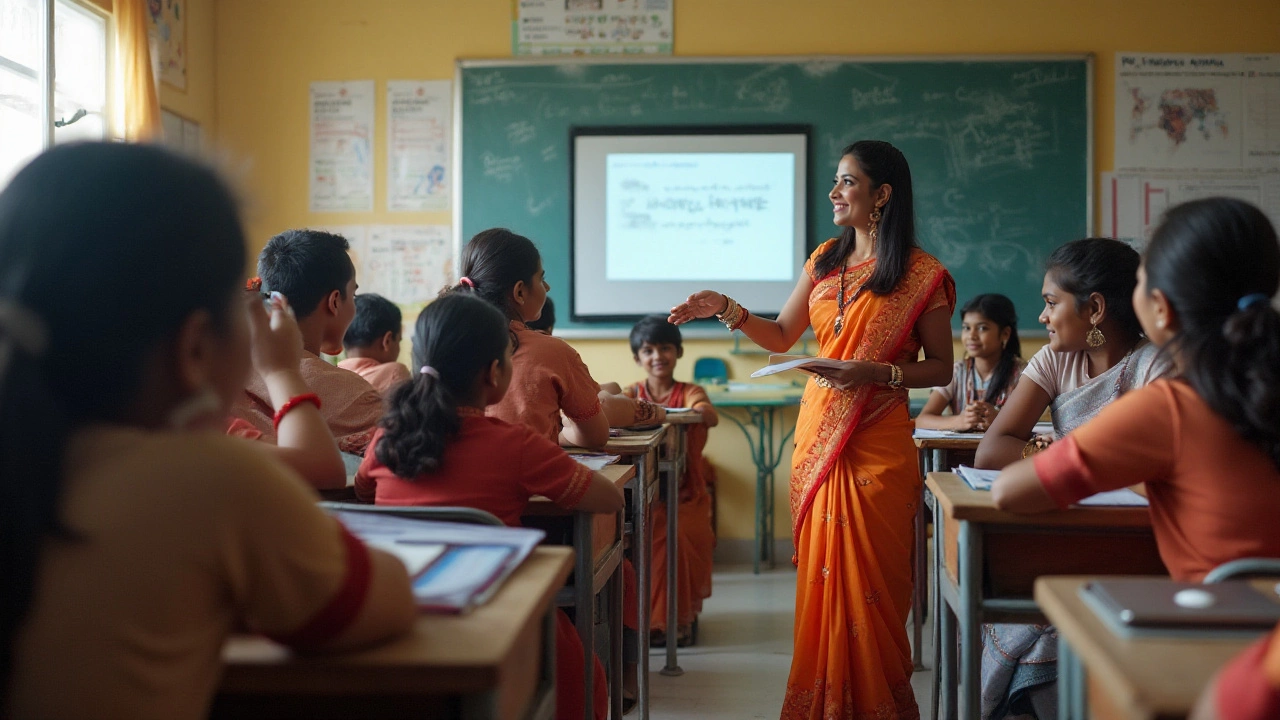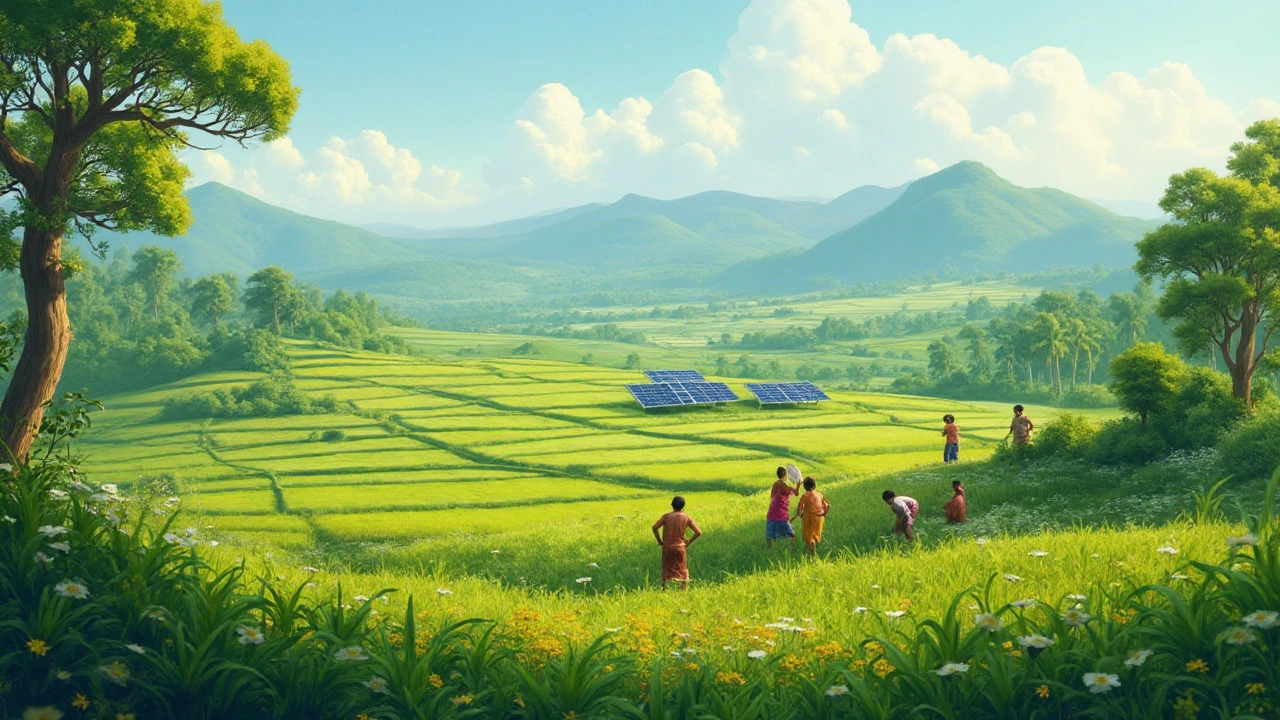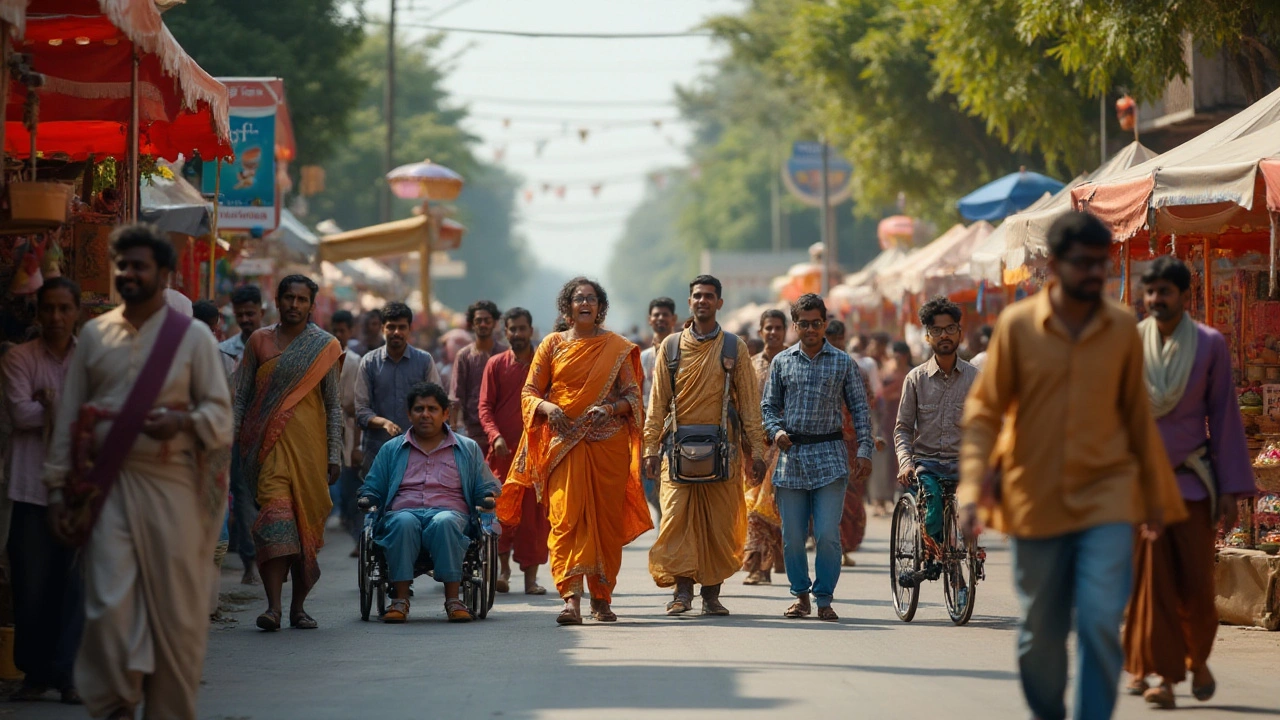Dreams for India's Future: A Vision for a Prosperous Nation
 Jan, 13 2025
Jan, 13 2025
The heart of India beats with dreams and hopes that echo the aspirations of millions. As we look toward the future, these dreams paint a vivid picture of what our nation could become. A country rich not only in its cultural heritage but in opportunities for all its citizens. The dreams of India encompass diverse aspirations, from a quality education for every child to the blossoming of economic opportunities that uplift every section of society.
There's an increasing awareness of the environment, urging us to move towards sustainability. Social equality remains a cornerstone of our dreams, as we strive to build a country where every individual stands shoulder to shoulder with dignity and respect. Technological and cultural innovations are shaping our society, leading the charge into a modern era, where India's identity shines brightly in a global tapestry.
- Educating the Next Generation
- Embracing Economic Opportunities
- Sustainability and Environmental Responsibility
- Promoting Social Equality
- Cultural and Technological Innovations
Educating the Next Generation
Education stands as the cornerstone upon which the future of any nation is built, and for India, this is no different. As the world’s largest democracy with a population that is predominantly young, the educational dreams for India are vast and ambitious. These dreams encompass not just access to education but the quality and relevance of what is being taught. A striking fact is that India aims to achieve a 100% literacy rate, a significant increase from the current national literacy rate of about 77.7%, as per the National Statistical Office's latest reports. Education reform is high on the agenda, ensuring that young Indians are equipped with critical thinking skills, creativity, and the innovation needed to thrive in the modern world.
India’s vision for educating the next generation aligns closely with the global shift towards STEM (Science, Technology, Engineering, and Mathematics) education, which is seen as a crucial driver for future economic prosperity. Yet, an integral part of this education dream is also the inclusion of arts and humanities to foster well-rounded individuals. A balance between both continues to be a challenge but one that India is excitingly embracing. From investing in infrastructure to pushing forward with digital education initiatives, the government has made strides in transforming the landscape, even planning to digitalize over 2 million schools by 2025.
A key policy that supports these efforts is the New Education Policy (NEP) 2020, which marks a paradigm shift in the way Indian students learn. NEP 2020 envisions an education system that contributes directly to transforming the country sustainably into a vibrant knowledge society. It seeks to replace rote learning with critical skills development, encouraging students to understand and engage with the world around them.
As Mahatma Gandhi once said, "Live as if you were to die tomorrow. Learn as if you were to live forever." This mindset encourages lifelong learning, opening doors for students to continue their education beyond traditional schooling.
India's dreams for education also involve bridging the urban-rural divide. Rural areas, isolated from the technological advancements of cities, often lag in terms of educational resources. Government initiatives like the Samagra Shiksha scheme aim to provide equal opportunities and resources, ensuring that educational dreams for rural children are not merely aspirations but achievable realities. Another important piece of the education puzzle is gender equality, which remains a priority. Empowering women through education not only addresses gender disparities but also leads to broader socio-economic benefits.
Looking forward, India aims to invest heavily in teacher training, recognizing that the educators themselves are vital to nurturing a truly world-class system. A robust teacher training program will ensure that educators are not just facilitators of knowledge but also mentors who inspire. Emphasizing experiential learning and collaborative projects prepares students to work in teams, solve real-world problems, and ultimately contribute effectively to India’s economy. Through education tailored to meet the demands of a rapidly changing world, dreams for India's youth flower into promising futures.
Embracing Economic Opportunities
India’s journey towards economic prosperity is marked by a landscape brimming with potential and opportunity. The vibrant energy of India's growth is mirrored in the entrepreneurial spirit that thrives across its length and breadth. From bustling metropolitan cities to remote rural areas, the pulse of entrepreneurial activity can be felt, promising a brighter future for all its inhabitants. The country has become a magnet for innovation, with young minds eager to leave their imprint on the fabric of the global economy. A key driver of this economic surge is the burgeoning start-up culture, which has seen a massive upswing in the last decade. India is now home to numerous unicorns, attracting investment from venture capitalists worldwide.
Government policies have also played an instrumental role in shaping an ecosystem that resonates with opportunity. Initiatives like 'Make in India' and 'Digital India' have aimed to cultivate a sector that is resilient and competitive on an international scale. These programs have not only spurred local manufacturing but also encouraged foreign companies to establish their footprint in India. Such structures usher in possibilities of job creation, improved infrastructure, and a knowledge-driven economy. Moreover, India's diverse market allows businesses to cater to an array of consumer preferences, driving innovation and tailoring solutions that meet unique local needs.
Technology has undeniably become a cornerstone of economic growth. As rural India steadily gains digital literacy, countless individuals are accessing the internet for the first time, opening doors to e-commerce, education, and financial services. The rise of digital payment platforms showcases India's adaptation to ultra-modern solutions, positioning the nation as a leader in fintech innovations. Despite challenges, the digital divide is closing, supported by smartphone penetration and expanding internet connectivity.
As remarked by Nandan Nilekani, co-founder of Infosys,
"The progress of digitization is not just about convenience, it’s about creating a vast platform where every Indian can participate in the future economic growth of this country."His words inspire us to envision a nation where technology serves as a fundamental backbone that supports inclusive development.
In consideration of the agricultural sector, one cannot overlook its substantial contribution to the economy. Technological advancements and sustainable practices are being introduced to ensure productivity and livelihood of the rural population. Think of precise weather forecasting tools or apps offering real-time market prices to farmers. These are not just technological growths; these present a paradigm shift that affects the heart of Indian society.
India's need to harness its demographic dividend is essential, with young workers entering the labor market at a significant rate. To capitalize on this human resource, skill development programs are crucial, equipping the youth with the skills necessary to navigate and excel in various industries. With a robust workforce and an adaptable industry, India's future in the global economic arena remains promising, and the opportunity to redefine its global economic standing has never been more compelling.

Sustainability and Environmental Responsibility
In India, the quest for sustainability and environmental responsibility has become a crucial part of the national dialogue. With a population exceeding 1.4 billion, India faces unique challenges and opportunities in environmental preservation. Urbanization and economic growth have left their mark on the country’s natural resources, compelling us to take a step back and reassess our relationship with the environment. As citizens of an ancient land, stewarding this heritage means ensuring that our economic development does not come at the expense of our ecological heritage. Initiatives like the Green India Mission and the National Clean Energy Fund illustrate our commitment to these goals.
The government has been actively pursuing policies aimed at increasing the share of renewable energy in the national grid. By 2030, nearly 50% of India’s total energy capacity is expected to come from non-fossil fuel sources. This shift is not merely a policy decision; it's a necessity driven by the commitment to reduce our carbon footprint. The vibrant landscape of solar and wind energy in regions like Gujarat and Tamil Nadu is testimony to a growing awareness that nature and progress can coexist harmoniously. The recent advent of electric vehicles and biofuels also marks significant strides toward a cleaner tomorrow.
Addressing environmental challenges also involves grassroots movements and community involvement. Many rural communities have undertaken tremendous efforts to encourage sustainable farming practices using traditional knowledge, which aims to restore soil health and foster biodiversity. Innovations in these domains are not new. One can look at the longstanding traditions of water conservation in Rajasthan or ecological housing practices in Kerala for examples of community-based solutions. A quote by Mahatma Gandhi often resonates in this context, "The Earth provides enough to satisfy every man's needs, but not every man's greed." This sentiment encapsulates the philosophy that underpins India's efforts.
Also notable are India's afforestation projects, which aim to restore and expand forests. Initiatives like the National Action Plan on Climate Change have set ambitious targets to increase forest cover and improve forest quality. With many cities confronting high levels of air pollution, tree plantation drives are not only reducing carbon dioxide but they are also enhancing urban living conditions. India has the opportunity to become a leader in sustainable development, as it integrates technological innovations with traditional practices, honoring the wisdom of the past while adapting for the future.
The educational sector plays a pivotal role in building sustainable awareness from a young age. School curriculums are evolving to include environmental sciences right from the primary level, sowing seeds of responsibility among the youth. By engaging children in activities like recycling and conservation projects, the future generation will be well-equipped to tackle environmental issues. Involving students in practical projects such as creating composts or tree-planting activities can foster a deeper understanding of sustainability.
Promoting Social Equality
Social equality is not merely a noble ideal; it's a fundamental pillar for India's future as a vibrant and equitable society. In recent years, India has made strides toward closing the social disparity gap, yet the journey is far from over. The Indian Constitution enshrines the principles of equality, promising every citizen the right to equal treatment regardless of caste, creed, gender, or religion. However, to breathe life into these words, society needs transformative actions that resonate with every individual's lived reality. One of the significant challenges remains the deep-rooted caste system which, despite being outlawed, still invisibly influences social dynamics across many regions. To dismantle structural inequalities, initiatives that promote inclusivity and representation in education and employment are crucial.
Education, often called the great equalizer, plays a pivotal role in achieving social equality. The focus should be on ensuring all children, irrespective of their background, receive quality education. Government initiatives like the Right to Education (RTE) Act have laid the foundation, yet the classroom reality often tells a different story. Striking a balance between urban and rural education facilities can be challenging yet necessary to prevent the widening of educational disparities. It is equally important to integrate diversity and inclusivity within educational content, teaching students the importance of empathy and respect from a young age. Moreover, skill development programs targeted at underrepresented communities can bridge employment gaps and uplift entire demographics, thus kindling dreams for a brighter India's future.
Gender equality remains another significant aspect of social equity. Despite advancements, many women still face hurdles in education, healthcare, and workplace settings. Initiatives like the Beti Bachao Beti Padhao (Save the Daughter, Educate the Daughter) campaign aim to reshape gender norms, but broader implementation and societal acceptance are essential. Encouraging more women to enter STEM fields, politics, and leadership roles when they possess the talent and zeal can enhance the country's potential manifold. In this context, influential voices reiterate the cause for equality. As activist Malala Yousafzai poignantly stated, "We cannot succeed when half of us are held back."
Economic empowerment is intricately linked to social equality. Access to resources and opportunities ubiquitously suggest advancements towards parity. The introduction of micro-financing and self-help groups has empowered numerous communities, enabling individuals from marginalized backgrounds to venture into entrepreneurship. By promoting small businesses, especially those led by women and minorities, we foster a cycle of growth that touches every segment of society. Encouraging equal pay and supportive work environments is a critical step in knitting a fairer economic fabric for all. It's a testament to how prosperity in India can be realized when every voice is acknowledged and empowered.
A shift in social norms and values is equally necessary. Biases and stereotypes need challenging, often beginning within our homes and extending to workplaces and larger social circles. Comprehensive policies and effective community-level interventions can push boundaries, creating spaces where social dialogue flourishes. Government, non-profits, and civil society roles are to work in tandem, leading campaigns promoting respect, tolerance, and equality. These changes, though gradual, ripple through each facet of society, and with unity in diversity, the dream of greater social equality brings prosperity in India ever closer within reach.

Cultural and Technological Innovations
India has always been a land of cultural and technological innovations, a melting pot where ancient traditions blend with modern advancements to create a unique and dynamic society. With its rich tapestry of languages, beliefs, and practices, India offers a vibrant canvas for artistic expressions and technological breakthroughs. The fusion of culture and technology has led to a creative resurgence that is capturing the world's attention and setting a precedent for the future.
One of the most remarkable aspects of India's journey is its ability to retain its cultural essence while embracing modernity. This harmonious balance is evident in the world of communication, where social media platforms become conduits for the cultural heritage and traditions of India to disseminate globally. From Instagram influencers celebrating Indian festivals to YouTubers creating content in regional languages, digital spaces are alive with Indian creativity. The famous Bollywood industry, too, is now embracing new technology, integrating cutting-edge CGI and promoting India’s stories to a global audience.
The technological landscape in India has witnessed an unprecedented boom, becoming a hotbed for startups and tech entrepreneurship. Cities like Bengaluru and Hyderabad are now known as Silicon Valley counterparts, nurturing a breed of innovators who are working to solve global challenges with localized solutions. With the rapid adoption of AI and blockchain technology, sectors such as healthcare, agriculture, and finance are undergoing a transformative change, bringing more efficiency and inclusivity. Today, India not only uses technology, it redefines it, crafting a sustainable and prosperous tomorrow.
In the realm of education, cultural and technological innovations are reshaping how knowledge is imparted. E-learning platforms are enabling students from rural areas to gain access to quality education previously unthinkable. The focus on coding and development in early education stages is empowering the next generation to build skills that will allow them to take part in the global digital economy. The collaboration of cultural education with digital tools ensures that young minds are not just tech-savvy but also culturally grounded, ready to launch India towards new horizons.
These collective innovations are often propelled by a philosophy deeply rooted in India’s way of life – "Vasudhaiva Kutumbakam," meaning 'the world is one family.' This idea fuels a profound responsibility and active engagement in addressing global issues. Innovators and cultural custodians strive for solutions that are not only beneficial locally but have the potential to be mirrored elsewhere. The youth, particularly, play a significant role in propelling this ideology, bridging gaps between cultures and fostering an open worldview.
"The explosion of Indian culture via technology is a revolution that's democratizing creativity," says cultural critic Bharati Bhargava. "It's not just about exporting culture; it's about transforming it for future generations."
India's fusion of tradition and innovation creates an environment where possibilities are limitless. As technologies like blockchain and AI continue to evolve, their applications across diverse sectors will further reveal what this amazing synergy can achieve. And although the journey is complex, India’s cultural and technological innovations remain a guiding light, steering both the nation and the world toward new horizons, replete with opportunity and promise.